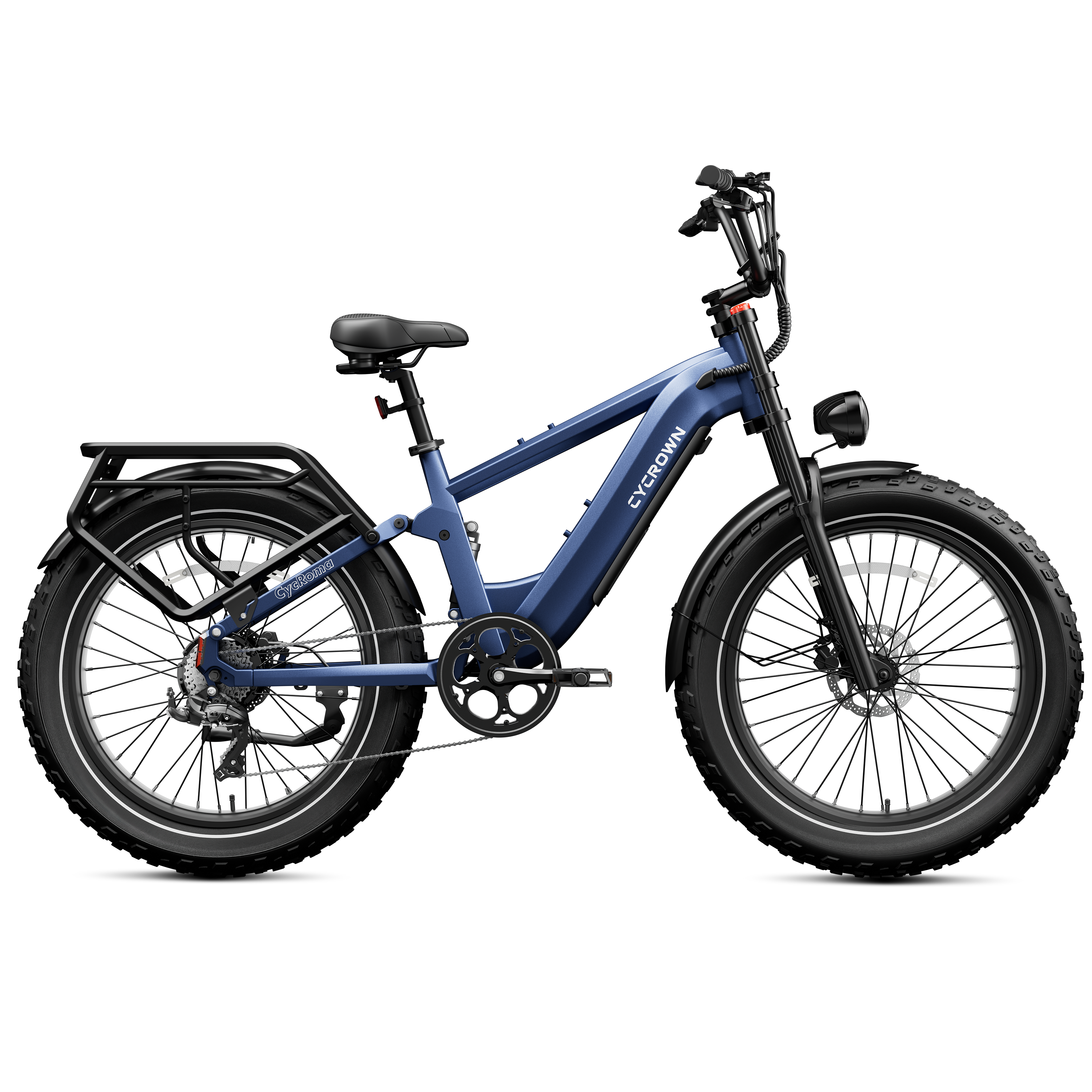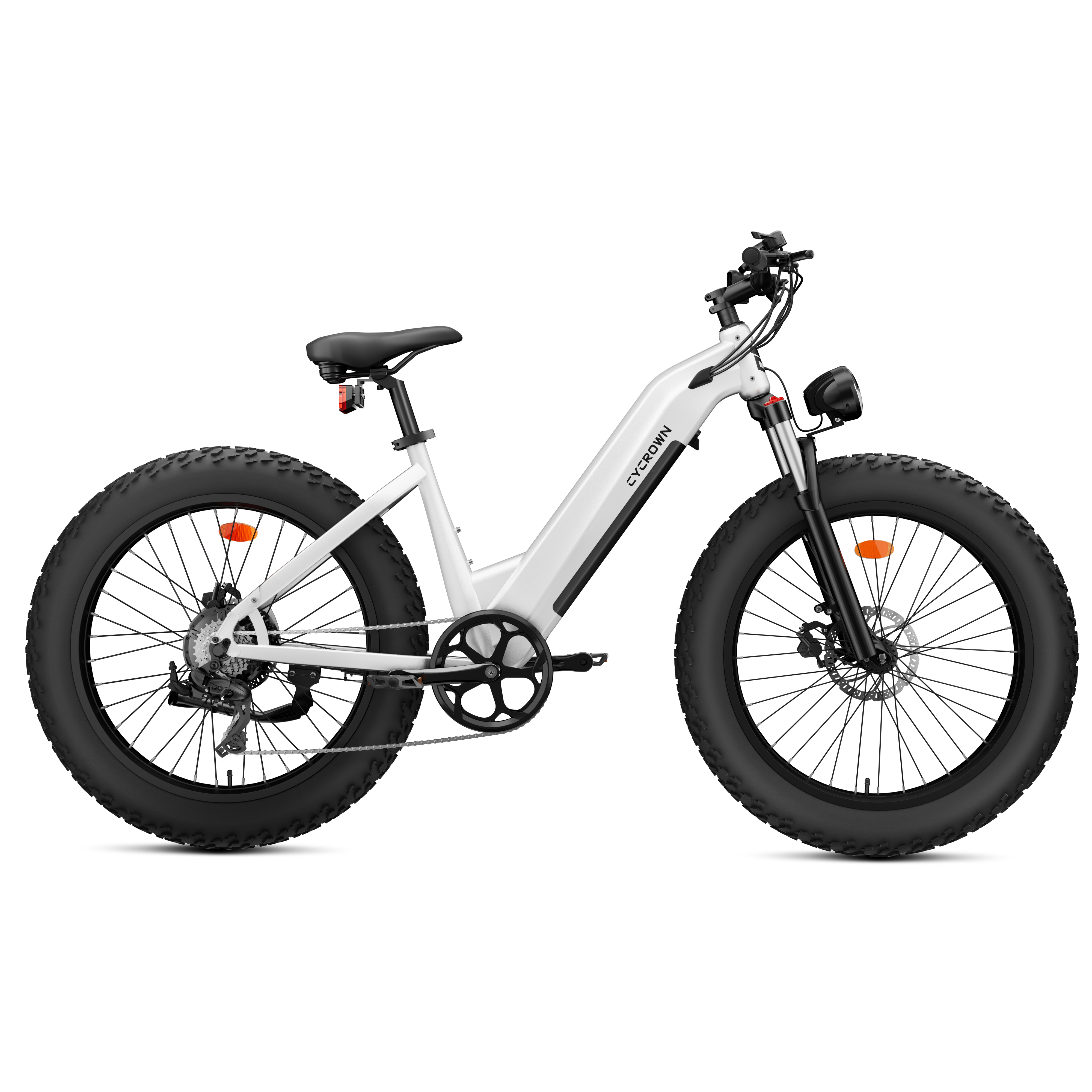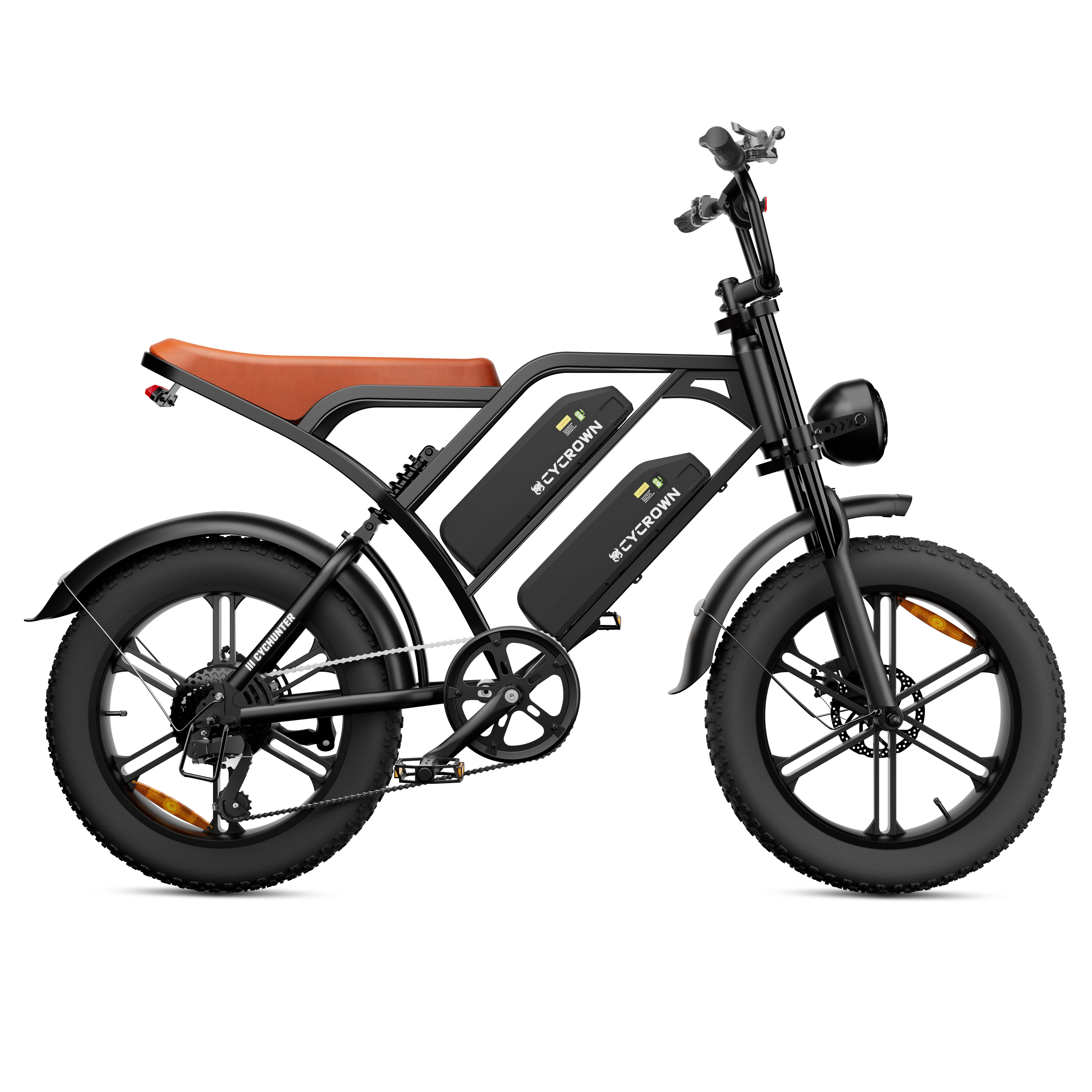Step-thru and step-over frames are commonly seen in electric bike designs, and having a clear understanding of the distinctions between them is crucial when choosing the ideal frame for your ride. This post highlights the key differences between these two bike frames and outlines their advantages and disadvantages respectively.
What Is a Step-Thru Electric Bike?
Step-thru electric bikes feature a unique curved frame, characterized by a low or absent top tube while maintaining a slanted down tube connecting the handlebars to the pedal area. This design eliminates the top portion of the traditional triangle shape of most bicycles. Initially created to accommodate riders wearing dresses, the step-thru design has gained popularity over the years, offering comfort and style.
What Are the Pros of Step-Thru Bikes?
Step-thru bikes are praised for many advantages, including ease of mounting, convenience for carrying cargo, and stability.
Easy Mounting and Dismounting
Step-thru bikes offer unparalleled ease of mounting and dismounting, ideal for older riders or those struggling with lifting their leg over a traditional bike frame. Additionally, step-thru bikes are perfect for commuting to work, especially when wearing formal attire that demands flexibility.
Cargo Convenience
Step-thru bikes are a fantastic alternative for individuals carrying parcels or navigating traffic. If you're using a delivery e-bike loaded with multiple boxes and bags, a step-thru bike offers convenience for riders who frequently need to hop on and off the seat throughout the day. With its easy-mounting design, these bikes ensure efficient and hassle-free transportation, enhancing productivity and maneuverability for busy riders.

Shop Now: CycWagen Dual Battery Step-Thru Cargo Ebike
Stability
Step-thru e-bikes are an exceptional choice for heavy adults, offering accessibility and ease of use. The low, step-thru frame enables effortless mounting and dismounting—a significant advantage for individuals with limited mobility or excess weight.
Moreover, the electric motor assistance makes pedaling more manageable, reducing strain on joints and muscles. This feature transforms step-thru e-bikes into comfortable and enjoyable options for heavy riders seeking an active lifestyle.
What Are the Cons of Step-Thru Bikes?
Step-thru e-bikes, while convenient, still have disadvantages compared to step-over bikes. Here are a few downsides to the design of step-thru frames:
Less Sturdy
Step-thru bikes don't have the top bar securing the front and back of the frame together, they can be perceived as less sturdy than a conventional bike. Some users feel that step-thru bikes are "floppier" and less stiff, which might affect the handling, especially in off-road conditions.
Potential Bike Weight
Due to their less sturdy nature, step-thru bikes are often constructed using more durable materials, resulting in a slightly heavier weight. This deliberate design choice prioritizes the bike's overall sturdiness and safety.
However, it's important to note that the weight of step-thru bikes can vary depending on the style and model, which may impact performance and the rider's experience. The added weight can make it slightly more challenging to balance the bike before taking off or at a standstill.
Not Suitable for Aggressive Riding
Traditionally, step-thru bikes were considered unsuitable for riders seeking higher speeds, making them less ideal for track cyclists. However, with the advent of electric bikes, step-thru models have become just as fast as their step-over counterparts.

Shop Now: CycFree Step-Thru Electric Commuter Bike
Despite this improvement, there may be better choices than step-thru bikes for aggressive riding or tackling steep hilled terrains, as the frame design may feel less stable and pose potential safety risks.
What Is a Step-Over Electric Bike?
Step-over electric bikes boast frames designed with a traditional triangle shape, featuring a slanted down tube connecting the handlebars to the pedal area and a horizontal top tube connecting the seat post to the front handlebars. Furthermore, step-over e-bikes are typically constructed using thinner and lighter materials, enhancing their overall maneuverability and responsiveness.
What Are the Pros of Step-Over Bikes?
When people think of a bicycle, the familiar step-over design often comes to mind, and there are compelling reasons for its enduring popularity.
Familiar, Tried & True Design
One of the most significant benefits of step-over bicycles is their longevity. When investing in a bike, you want assurance that it will stand the test of time. Step-over bikes feature a tried and true geometry design, providing reliability and durability that can last thousands of miles.
All-Terrain Mobility
Step-over electric bicycles are generally designed to tackle various terrains. Whether you enjoy climbing hills or venturing off-road, a step-over bike's sturdy frame geometry enables it to handle diverse riding conditions. Its versatility ensures you can embark on any kind of ride with confidence.
Quality Materials
Step-over bikes often incorporate lightweight materials, enhancing their performance. The frame design ensures strength while reducing weight, allowing riders to reach higher speeds and cover greater distances with less energy expenditure. While this advantage is more prominent for step-over bikes, it's worth noting that step-thru e-bike designs can also achieve speeds up to 28mph, depending on the chosen model.

Shop Now: CycUltra All-Terrain Step-Over Electric Bike
What Are the Cons of Step-Over Bikes?
While step-over e-bikes offer numerous advantages, it is important to consider a few drawbacks associated with the design of step-over frames.
Difficult Mounting and Dismounting
The challenge of mounting and dismounting a bike with a higher-top tube primarily stems from the physical effort and flexibility required to lift one's leg over the tube. Here's a breakdown of why this can be particularly challenging for certain riders:
- Limited Mobility and Flexibility: Riders with restricted movement or flexibility issues may face difficulty raising their leg high enough to clear the top tube. This can be attributed to age, injury, disability, or a lack of flexibility.
- Clothing Constraints: Wearing skirts, dresses, or other restrictive outfits can impede lifting the leg comfortably and adequately without risking entanglement or discomfort.
- Physical Limitations: Individuals with specific physical limitations, such as joint pain, balance issues, or reduced strength, may find lifting their leg over a high-top tube excessively demanding or even painful.
Inconvenience With Heavy Loads
The inconvenience of dealing with heavy loads on a step-over bike stems from the difficulty of swinging your leg over the top tube when cargo is situated at the rear. Here's a breakdown of why this can be challenging:
- Limited Space: When cargo is present, particularly if it's bulky or extends above the rear rack's height, it reduces the space for your leg to pass over the top tube. This limitation can make mounting or dismounting awkward, potentially causing disturbance to the cargo.
- Less Stability: The presence of heavy or unevenly distributed cargo alters the bike's center of gravity, compromising stability. Attempting to lift your leg over the top tube in such circumstances heightens the risk of the bike tipping or the cargo shifting, potentially resulting in falls or damage.
- Physical Exertion: Swinging your leg over the top tube while coping with additional weight on the bike demands more effort and balance. For riders with limited strength or flexibility, this can pose a physical challenge.
- Safety Concerns: Maneuvering your leg over the top tube while avoiding cargo can lead to awkward movements, increasing the risk of injury or accidents, especially in tight spaces or when rushed.
Potential Risks
Safety concerns regarding step-over bicycles, particularly in emergencies or quick stops, arise due to the potential hindrance in rapid dismounting caused by the higher frame design. Here's why this concern is significant:
- Delayed Dismounting: In emergencies or when an abrupt stop is required, swift dismounting is crucial to avoid danger or collisions. The high-top tube of a step-over bike necessitates lifting the leg over the frame, leading to additional time and effort, potentially delaying the dismounting process.
- Reduced Stability: During sudden stops, the rider's balance can be compromised, especially when maneuvering the leg over a high-top tube. This reduced stability increases the risk of falling or losing control of the bike, potentially exacerbating the hazardous situation.
- Limited Maneuverability: In urgent scenarios, the ability to quickly disengage from the bike is paramount. The high frame design can limit maneuverability, making it more challenging for riders to swiftly step away from the bike or navigate around obstacles, potentially impeding their response to the emergency.
- Physical Restrictions: Riders with limited mobility, and flexibility, or those wearing certain types of clothing may encounter particular difficulties in quickly dismounting from a high-top tube. These factors can increase vulnerability in sudden emergencies, potentially compromising the rider's safety.
How to Choose the Right Frame Type?
Both step-thru and step-over bicycle have their distinct characteristics, and the choice ultimately depends on your riding style and preferences. If you're unsure about which bike is best suited for you, consider asking yourself a few simple questions:
- What is the main use of the bike? If you plan to use it for commuting, leisurely rides, or running errands, both step-thru and step-over bikes can be suitable. However, if you have specific requirements, such as carrying heavy loads or navigating challenging terrains, it may influence your choice.
- What type of terrain will I be riding on most? Step-over bikes generally offer better stability and control, making them well-suited for off-road or hilly terrains. On the other hand, step-thru bikes excel in urban environments and flat terrains, providing easier mounting and dismounting.
- What type of accommodations will I need to secure or store the bike? If you have limited storage space or require frequent locking and securing, a step-thru bike's compact design and ease of handling may be advantageous. Step-over bikes, though larger, can offer additional options for attaching racks or accessories.
Considering these questions can help you navigate the decision-making process and determine whether a step-thru or step-over bike aligns better with your needs and preferences.










